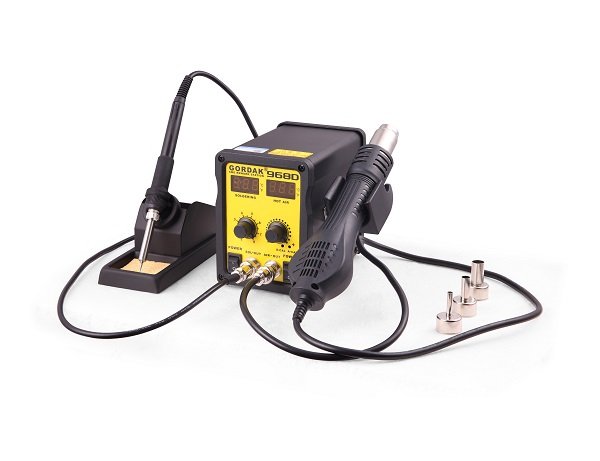Depending on your applications and budget, you might be wondering about the right approach to take when working on printed circuit boards, or PCBs. When it comes to the technology involved in heating up solder paste and installing or replacing electronic components, there’s an ongoing debate surrounding which type of rework equipment to use.
Much of this debate comes down to whether to use a hot air rework station or a heat gun. Let’s take a look at the advantages and disadvantages involved in each method, so you can determine the best choice for your needs.

Hot Air Rework Stations — Pros and Cons
As its name implies, a hot air rework station uses heated air — directed by varying sizes of nozzles — to evenly and quickly heat the PCB area you’ll be working on. Typically, a pump activates to circulate fresh air over a heating coil. Depending on which type of rework station you use, the pump’s action can produce noise that some operators find distracting. However, since you can precisely direct a rework station’s nozzle to the area you’re working on, the heated airflow occurs rapidly — so you can complete your work efficiently.
Another benefit of using hot air rework stations is that they can double as soldering stations as well. With a hot air station, you can remove broken or old components and — after thoroughly cleaning and prepping the area — use the same station to solder new pieces onto the existing PCB. Also, since most hot air stations operate on a non-contact method, you’re far more likely to avoid damaging other areas of the circuit.
Hot Air Guns — Pros and Cons
Some hobbyists note that an alternative to hot air rework stations is hot air guns — often made exclusively for embossing jobs. Hot air guns produce heated airflow that can melt solder and remove components — like ICs — from PCBs. The most significant advantage of these hot air guns is their low cost. Hot air guns are available for a fraction of the price of a professional hot air rework station. But if you’re serious about working on PCBs, this is where the advantages of hot air guns end.
Because hot air guns heat a large portion of any PCB you’re working on, they can also cause significant damage to other components, as well as the board’s laminate. And because hot air guns aren’t as accurate as rework stations, your resulting work area can wind up being pretty messy.

What can I use instead of a heat gun?
Soldering Iron
If you are working on a smaller surface area that requires more precision and delicate craftsmanship, you can use a soldering iron.
Lighter
For a quick and small fix on the go, you can give your good old BIC lighter a try. Just remember to watch your fingers.
Matches
If you don’t have a lighter, you can use matches as well. What’s more, many people find match sticks easier to control and maneuver than lighters.
Clothing Iron
Your clothing iron is another everyday household item that can replace — within limits — a heat gun. Plug the iron in, stand it upright, and hold the object you want to treat close to the iron without touching it. Slowly move the object in front of the iron to ensure that the entire surface area receives the same amount of heat exposure. Remember to take your time and be patient.
Contact Gordak for a quality rework station
For more information on hot air rework stations, as well as our training for their competent use, feel free to contact us today.



